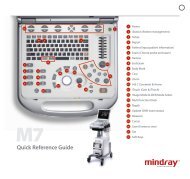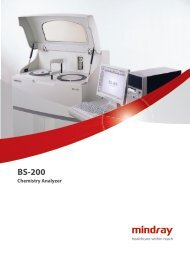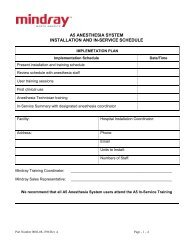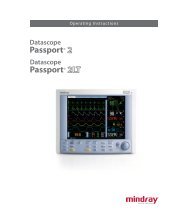Passport® - Mindray
Passport® - Mindray
Passport® - Mindray
- TAGS
- mindray
- res.mindray.com
You also want an ePaper? Increase the reach of your titles
YUMPU automatically turns print PDFs into web optimized ePapers that Google loves.
ECG Monitoring Preparation and Lead Placement<br />
4.5 Preparation and Lead Placement<br />
4.5.1 Skin Preparation<br />
Proper skin preparation is essential in obtaining an accurate ECG reading. Electrode sites<br />
should be clean and dry and should provide a smooth flat surface. Incidental electrical<br />
activity and inaccurate readings may arise from incorrect skin preparation.<br />
The following procedure is recommended for secure electrode patch application:<br />
1. Shave the chest hair from the electrode sites in a circular area with a diameter of<br />
2 – 4 inches.<br />
2. Use a dry gauze pad to remove excess skin oils, skin cells and residue from the<br />
electrode sites. Never rub the skin until it is raw or bleeding.<br />
NOTE: Prepare the electrode site with alcohol only if the skin is<br />
extremely greasy. If alcohol is used as a drying agent,<br />
always allow the skin to dry before placing the electrode<br />
patch on the skin.<br />
4.5.2 Electrode Patch Location<br />
NOTE: Store electrode patches at room temperature and open just<br />
prior to use.<br />
NOTE: Avoid more than one type of electrode on a patient because<br />
of variations in electrical resistance.<br />
NOTE: Avoid placing electrode patches directly over bone<br />
prominences or over any high activity movement areas such<br />
as shoulders or arms because muscle motion produces<br />
electrical activity. If an electrode patch is placed over a large<br />
muscle such as the pectorals, the monitor may detect this<br />
additional muscle activity and could lead to false<br />
arrhythmia calls.<br />
NOTE: Using a Transcutaneous Electrical Nerve Stimulator (TENS):<br />
Since a TENS unit transmits electrical impulses, avoid placing<br />
ECG electrode patches near the TENS electrodes. ECG<br />
electrode patches may need to be repositioned and the ECG<br />
lead viewed may need to be adjusted until the optimum ECG<br />
tracing is obtained.<br />
1. To prevent evaporation of the contact gel medium, peel the backing off of the electrode<br />
patch only when it is ready for use. Visually inspect the contact gel medium for<br />
moistness. If the gel medium is not moist, do not use the electrode patch. Dry electrode<br />
patches are not conductive.<br />
NOTE: If using the snap type electrode wires, attach the electrode<br />
patch to the lead wire before placing patch on the patient.<br />
Passport V Operating Instructions 0070-10-0704-02 4 - 15












